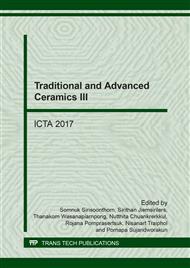p.1
p.7
p.13
p.19
p.28
p.34
p.40
p.44
p.51
The Effect of Decolorizing Agent on the Optical Properties of High Iron Contents Soda-Lime Silicate Glass
Abstract:
The aim of this study is to decolorize the high iron content (more than 0.1 %wt Fe2O3) glass. The contained 0.13 wt% iron oxide (Fe2O3) soda-lime silicate is prepared by high iron content sand with 0.17 wt% of Fe2O3. Iron oxide in soda-lime glass presents in two forms, Fe2+ (green) « Fe3+ (yellow). In principle, high iron content sand is not suitable to produce tableware. Therefore, the glass manufactures require high purity of sand because they want to control the amount of iron oxide as low as possible, which usually tableware glass contains only small amount of iron oxide (0.01 - 0.04 wt% Fe2O3) to avoid iron effect (green color). The soda-lime silicate glasses is decolorized by three different agents, Neodymium oxide (Nd2O3), Manganese oxide (MnO2), and Tin oxide (SnO2) 0.125 0.25 0.50 1.00 and 2.00 %wt respectively. The glasses are melted twice in the platinum crucible and investigated of the optical properties by UV-Vis spectrophotometer. The results of the color in CIE L*a*b* system are found that glass containing MnO2 and SnO2 slightly changes to white shade, but still presents in green. However, the result of contained 1.00 and 2.00 %wt SnO2 glasses is nearly cleared, the result of contained Nd2O3 glasses are satisfied, and the contained 0.25 %wt Nd2O3 glass is showed very clear. Anywise the color of glasses containing 1.00 and 2.00 %wt Nd2O3 turned to blue. The reaction of glasses containing Mn and Sn occur according to the mechanism of chemical decolorization. The reactions was described by the following equation, Fe2+ + Mn3+ g Fe3+ + Mn2+ and Fe2+ + Sn5+ f Fe3+ + Sn4+, but the reactions are limited and strongly depending on the redox equilibrium. For Nd2O3, the reaction presents according to physical decolorization, because the color of Nd2O3 is stable in melted glass and it can dismissed the color of Fe2O3 directly. Therefore, this method can apply for the tableware glass production with high iron content sand.
Info:
Periodical:
Pages:
28-33
Citation:
Online since:
April 2018
Price:
Сopyright:
© 2018 Trans Tech Publications Ltd. All Rights Reserved
Share:
Citation:


